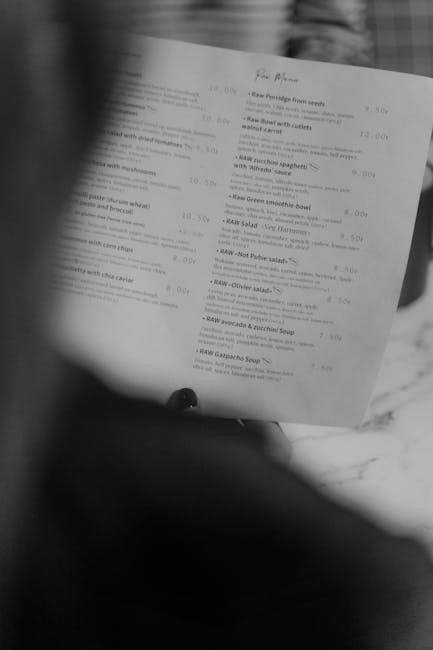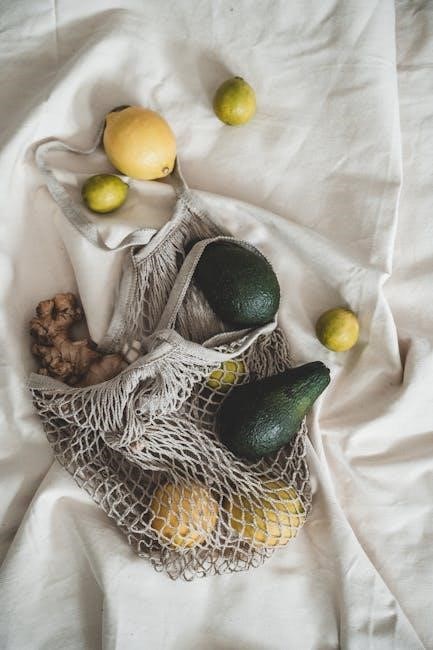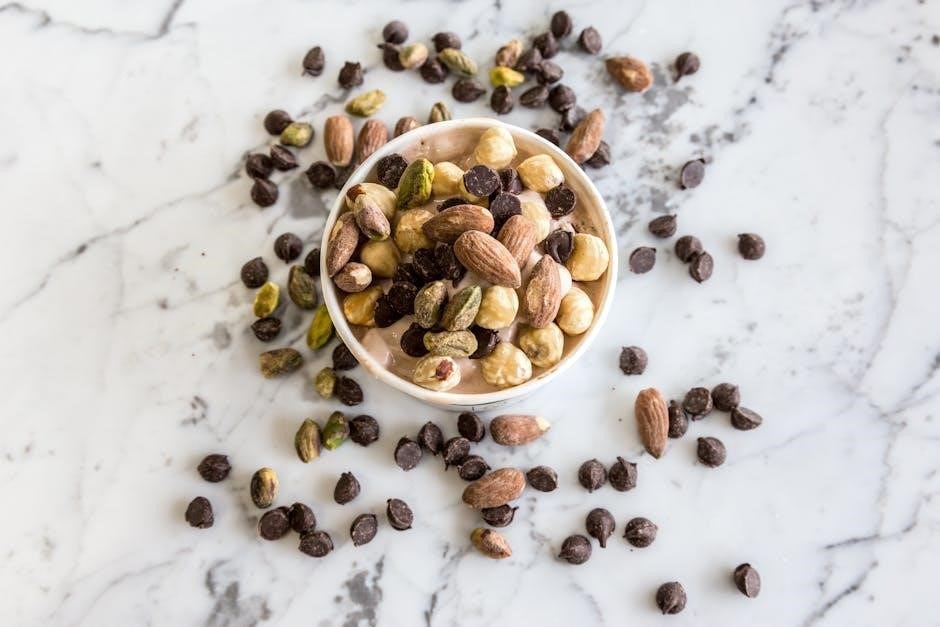Lectins are plant proteins found in common foods like beans and grains. A lectin-free diet, popularized by Dr. Gundry’s Plant Paradox, aims to reduce inflammation and improve health by eliminating high-lectin foods. Digital guides and PDF lists provide detailed food recommendations, helping individuals navigate this dietary approach effectively.
What Are Lectins and Why Avoid Them?
Lectins are naturally occurring proteins found in plants, particularly in beans, legumes, and nightshades. While they serve as a defense mechanism for plants, certain lectins can cause inflammation, digestive issues, and disrupt gut health in humans. Avoiding high-lectin foods may help reduce inflammation, improve digestion, and promote overall well-being. Some experts, like Dr. Gundry, suggest that limiting lectin intake can lead to better nutrient absorption and reduced chronic disease risk, making it a popular choice for those seeking improved health outcomes.
The Purpose of a Lectin-Free Diet
The primary goal of a lectin-free diet is to minimize inflammation and improve digestive health by eliminating foods high in lectins. This dietary approach aims to reduce symptoms associated with lectin sensitivity, such as bloating and joint pain. By focusing on low-lectin or lectin-free foods, individuals can potentially enhance nutrient absorption and support overall well-being. The diet also encourages the consumption of nutrient-dense foods, promoting a balanced and healthier lifestyle. Many followers report improved energy levels and reduced chronic inflammation as key benefits.

Benefits of a Lectin-Free Diet
A lectin-free diet promotes weight loss, improves overall health, and reduces inflammation. It enhances digestion, minimizes bloating, and supports nutrient absorption. Many followers report feeling more energetic and experiencing fewer digestive issues, making it a popular choice for those seeking better well-being.
Weight Loss and Improved Health

A lectin-free diet often leads to weight loss and improved health by eliminating inflammatory foods. By removing high-lectin foods like beans and grains, the body sheds excess pounds more easily. Enhanced digestion and reduced inflammation promote better nutrient absorption and overall well-being. Many followers report feeling lighter, experiencing fewer digestive issues, and having more energy. Additionally, the focus on nutrient-dense foods like leafy greens and pastured meats supports long-term health benefits, making it a sustainable choice for those seeking a healthier lifestyle.
Reduced Inflammation and Digestive Issues
A lectin-free diet can significantly reduce inflammation and alleviate digestive problems. Lectins, found in beans, nightshades, and grains, can irritate the gut, causing bloating, cramps, and inflammation. By eliminating these triggers, individuals often experience smoother digestion, reduced inflammation, and relief from conditions like leaky gut syndrome. The diet focuses on easily digestible foods, promoting a healthier gut microbiome and overall well-being. This approach is particularly beneficial for those with chronic digestive issues or autoimmune conditions.

Lectin-Free Food List: Allowed Foods
A lectin-free diet emphasizes animal proteins, low-lectin vegetables, and grain-free options. PDF guides detail approved foods, helping users avoid high-lectin ingredients and stick to the plan effectively.
Animal Protein Sources (Meat, Fish, Eggs)
Animal proteins are a cornerstone of a lectin-free diet, as they are naturally low in lectins. Dr. Gundry recommends pastured poultry, wild-caught fish, and eggs from omega-3 enriched or pastured sources. Meats like grass-fed beef, duck, and turkey are also allowed, provided they are free from soy and corn feed. Portion sizes are typically 2-4 ounces per serving for meats and up to 4 egg yolks daily. These options are rich in nutrients and align with the diet’s focus on reducing inflammation and improving digestion. Always choose high-quality, grain-free sources for optimal benefits.
Lectin-Free Vegetables and Fruits
Lectin-free vegetables and fruits are a cornerstone of this diet, focusing on low-lectin options like broccoli, cauliflower, spinach, and leafy greens. Berries such as blueberries and raspberries are recommended for their anti-inflammatory properties. Avoid high-lectin plants like nightshades (tomatoes, peppers, eggplants) and some starchy vegetables. Dr. Gundry emphasizes choosing seasonal, non-GMO, and organic produce to maximize nutrient intake and minimize lectin exposure. These foods support gut health and provide essential vitamins and antioxidants for overall well-being.

Grain-Free and Gluten-Free Options
Grain-free and gluten-free options are essential for a lectin-free diet, eliminating wheat, barley, and rye. Alternatives like almond flour, coconut flour, and cauliflower-based products are ideal. Dr. Gundry recommends avoiding grains with high lectin content, such as corn and oats. Opt for gluten-free products made from rice, quinoa, or ancient grains like millet. These substitutions help reduce lectin intake while maintaining dietary variety and satisfaction, supporting overall digestive health and inflammation reduction.

Foods to Avoid on a Lectin-Free Diet
High-lectin foods like beans, legumes, nightshades, and certain grains should be avoided. Processed foods and hidden lectin sources also pose risks, requiring careful elimination for optimal benefits.
High-Lectin Foods (Beans, Legumes, Nightshades)
Beans, legumes, lentils, soybeans, and peanuts are high in lectins, which can cause inflammation and digestive issues. Nightshades like tomatoes, potatoes, and eggplants also contain lectins. Dr. Gundry recommends limiting or avoiding these foods to reduce lectin intake. Proper cooking methods, such as soaking and boiling, can reduce lectin levels in beans, but many remain problematic. These foods are often linked to gut discomfort and are a primary focus of elimination in a lectin-free diet plan.
Processed Foods and Hidden Sources of Lectins
Processed foods often contain hidden lectins from ingredients like soy, corn, and wheat. Many packaged snacks, breads, and even gluten-free products may include lectin-rich flours. Dairy products, especially those from non-A2 cows, can also pose risks. Condiments and spices, such as black pepper and nutmeg, may have trace amounts of lectins. Dr. Gundry’s food list highlights these sources, emphasizing the need to read labels carefully and opt for lectin-free alternatives to maintain a strict diet and avoid unintended lectin consumption.

How to Reduce Lectin Levels in Food
Soaking, cooking, and fermentation effectively reduce lectin levels in foods like beans and grains. Cooking destroys most lectins, while fermentation breaks down remaining compounds, enhancing digestibility and safety.
Soaking, Cooking, and Fermentation Techniques
Soaking beans for 2 hours and cooking significantly reduces lectin content. Fermentation breaks down lectins further, making foods safer and more digestible. Sprouting and pressure cooking also help lower lectin levels. These methods ensure foods like legumes and grains are easier on the gut, promoting better nutrient absorption and overall health.

Expert Recommendations and Resources
Dr. Gundry’s Plant Paradox Protocol offers expert guidance on lectin-free diets. Free PDF downloads, food lists, and printable guides simplify meal planning and grocery shopping.
Dr. Gundry’s Plant Paradox Protocol
Dr. Steven Gundry’s Plant Paradox Protocol emphasizes eliminating high-lectin foods to reduce inflammation and improve health. His approach includes detailed food lists, portion guidelines, and meal strategies. Gundry recommends prioritizing animal proteins, lectin-free vegetables, and A2 dairy products. He advises avoiding beans, legumes, and nightshades, which are high in lectins. The protocol also includes tips for reducing lectin content through soaking and cooking. Printable PDF guides and meal prepping strategies make following the diet manageable and sustainable for long-term health benefits.

Free PDF Downloads and Printable Guides
Free PDF downloads and printable guides provide convenient access to lectin-free diet resources. These guides list approved and avoid foods, offering clear meal planning and grocery shopping support. Printable lists can be taken to stores or placed on refrigerators as reminders. Digital versions enable easy access on phones for on-the-go decisions. Phase-specific food lists and comprehensive charts help users navigate the diet effortlessly, ensuring adherence and making the transition to a lectin-free lifestyle smoother and more organized.

Additional Tips for Success
Meal prepping and smart grocery shopping are key to adhering to a lectin-free diet. Use printable PDF guides as reminders and plan meals in advance for better compliance and convenience.
Meal Prepping and Grocery Shopping Strategies
Meal prepping is essential for maintaining a lectin-free diet. Plan weekly meals using your PDF food list to ensure compliance. Grocery shopping with a printed or digital list helps avoid high-lectin foods. Organize your pantry with approved items and prepare snacks in advance. Focus on fresh, whole foods like pastured meats, fish, and low-lectin vegetables. Combine this with strategic cooking techniques to simplify adherence and reduce temptation. A well-structured plan ensures long-term success and better health outcomes.
Combining Foods for Optimal Digestion
Combining foods strategically enhances digestion on a lectin-free diet. Pair leafy greens and cruciferous vegetables with healthy fats like avocado or olive oil to boost nutrient absorption. Include small portions of resistant starches, such as cooked and cooled potatoes, to support gut health. Opt for low-FODMAP vegetables like cucumbers and bell peppers to minimize digestive discomfort. Avoid mixing high-lectin foods with beneficial ones to prevent inflammation. Balance meals with protein, vegetables, and fats for optimal digestion and overall well-being;



